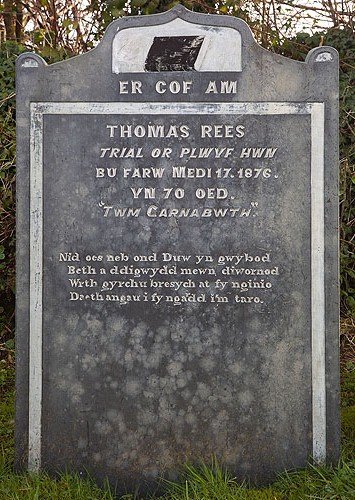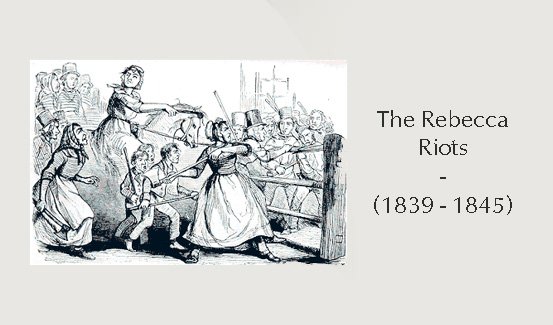The Rebecca Riots
The Rebecca Riots were a series of protests and riots that occurred in rural Wales during the 1830s and 1840s. The riots were a response to the poor economic conditions faced by Welsh farmers, who were struggling to make ends meet due to high taxes and low wages. The riots were named after the mythical figure of Rebecca, who was said to lead the protesters.
Background
In the early 19th century, Wales was a predominantly rural society, with farming being the main occupation of the majority of the population. However, the agricultural sector was in a state of crisis, with falling prices for farm produce and rising taxes.
The introduction of the new Poor Law system in 1834, which required local authorities to build workhouses for the destitute, added to the financial burden on the rural poor. To make matters worse, the imposition of tollgates on roads and new tollgates on smaller side roads had a drastic impact on the costs and time of local farmers looking to transport goods to markets.
The tolls also had a major impact on the cost of lime which was an essential fertilizer in the local area. These factors all combined to increase dramatically a feeling of oppression amongst the rural welsh and increase levels of poverty and deprivation.
Local people viewed the tolls and other factors as being imposed by outsiders or by Westminster and therefore they were seen as part of narrative of the repression of the rural Welsh by the English in general or by outsiders.
The Rebecca Riots
The first Rebecca Riot occurred in 1839, when a group of men dressed as women, with blackened faces and wearing bonnets and shawls, marched to the tollgate at Efailwen in Carmarthenshire. They demanded that the toll be abolished, as it was a burden on the already struggling farmers. When their demands were refused, they tore down the tollgate and continued their march. This marked the beginning of a series of protests and riots that lasted for several years.
The protesters, who were mostly farmers and agricultural labourers, targeted tollgates, workhouses, and other symbols of authority. They would often dress up as women, and call themselves ‘Merched Becca’ – Welsh for “Rebecca’s Girls”.
The use of ‘Merched Becca’ is thought to reference a verse in the Bible, Genesis 24:60 – ‘And they blessed Rebekah and said unto her, Thou art our sister, be thou the mother of thousands of millions, and let thy seed possess the gate of those which hate them‘. The use of feminine clothing was both a disguise and a way to mock the authorities. This cross-dressing also had roots in a local rural tradition known as ‘Ceffyl Pren’ (Welsh – ‘Wooden Horse’), which was common at the time of the Rebecca Riots. Ceffyl Pren involved men dressing in women’s clothing, blackening their faces and and conducting mock trials of wrong-doers in the community as a means of intimidation. Ceffyl Pren tended to occur where insufficient evidence for criminal cases existed or where the culprit had offended the morals of the locals – such as in cases of marital infidelity or informing to the authorities.
During the riots, before destroying the toll-gates, the leading ‘Rebecca’ would call to the assembled group of other Rebecca rioters and perform a short drama in the form of the following words:
Rebecca: “What is this my children? There is something in my way. I cannot go on….”
Rioters: “What is it, mother Rebecca? Nothing should stand in your way,”
Rebecca: “I do not know my children. I am old and cannot see well.”
Rioters: “Shall we come and move it out of your way mother Rebecca?”
Rebecca: “Wait! It feels like a big gate put across the road to stop your old mother.”
Rioters: “We will break it down, mother. Nothing stands in your way.”
Rebecca: “Perhaps it will open…Oh my dear children, it is locked and bolted. What can be done?”
Rioters: “It must be taken down, mother. You and your children must be able to pass.”
Rebecca: “Off with it then, my children.”
The riots were not limited to a single area, but spread throughout Wales, from Pembrokeshire in the west to Monmouthshire in the east. The protesters were often successful in achieving their aims, as the government was forced to reduce tolls, taxes (reducing the tax on lime by half) and improve conditions generally for the rural poor.
Timeline of Rebecca Riot Incidents
- Efailwen, Carmarthenshire – May 13, 1839
- Pwlltrap, Carmarthenshire – July 3, 1839
- Llanarthney, Carmarthenshire – July 7, 1839
- Pontardulais, Glamorgan – November 13, 1839
- Llandeilo, Carmarthenshire – November 13, 1839
- Newcastle Emlyn, Carmarthenshire – January 6, 1840
- Trelech, Carmarthenshire – February 18, 1840
- Llangadock, Carmarthenshire – February 28, 1840
- Llandovery, Carmarthenshire – March 28, 1840
- Eglwyswrw, Pembrokeshire – May 13, 1843
- Newport, Monmouthshire – May 24, 1843
- Haverfordwest, Pembrokeshire – May 27, 1843
- Fishguard, Pembrokeshire – June 7, 1843
- Llandeilo, Carmarthenshire – August 9, 1843
- Llanelli, Carmarthenshire – August 20, 1843
- Narberth, Pembrokeshire – August 23, 1843
- Kidwelly, Carmarthenshire – November 12, 1843
- St. Clears, Carmarthenshire – December 14, 1843
- Haverfordwest, Pembrokeshire – December 18, 1843
- Cardigan, Cardiganshire – January 6, 1844
- Llannon, Carmarthenshire – April 2, 1844
- Llanelly, Carmarthenshire – May 4, 1844
- Aberystwyth, Cardiganshire – June 6, 1843
- Cilgerran, Pembrokeshire – June 8, 1844
- Narberth, Pembrokeshire – June 10, 1844
- Llansamlet, Glamorgan – June 27, 1844
- Llanelly, Carmarthenshire – July 20, 1844
- Llanrhidian, Glamorgan – July 27, 1844
- Llanfihangel-ar-Arth, Carmarthenshire – August 12, 1844
- Kidwelly, Carmarthenshire – August 14, 1844
- Carmarthen, Carmarthenshire – August 14, 1844
- Llandeilo, Carmarthenshire – August 15, 1844
- Pontardawe, Glamorgan – August 17, 1844
- Brecon, Breconshire – October 7, 1844
- Carmarthen, Carmarthenshire – January 19, 1845
Twm’s grave can be visited today – it has the following inscription:
“Nid oes neb ond Duw yn gwybod/ Beth a ddigwydd mewn diwrnod. Wrth gyrchu bresych at fy nginio,/ Daeth angau i fy ngardd i’m taro”.
“No one but God knows what may happen in one day. While fetching a cabbage for my dinner, death came into my garden and struck me”
The Rebecca Riots were a significant event in Welsh history, and they had a lasting impact on Welsh culture and identity. They are often seen as a symbol of Welsh resistance to English domination, and they played a role in the emergence of Welsh nationalism in the 19th century.
The Rebecca Riots also had a wider significance, as they were part of a broader movement for social and political reform in Britain. The riots were a response to the economic hardship faced by the rural poor, and they highlighted the need for social justice and equality.
Conclusion
The Rebecca Riots were a unique and powerful form of protest, which challenged the authority of the state and the economic system that oppressed the rural poor. The protesters were able to achieve some of their goals, but the riots also had wider significance, as they contributed to the broader movement for social and political reform in Britain.

Get in touch with us!


